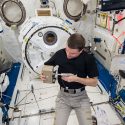Physicists say multi-million dollar experiment advancing smoothly
An international team of scientists led by the Fermi National Accelerator Laboratory, or Fermilab, today described early results from a $170 million project that seeks to better understand neutrinos, the elusive subatomic particles that have intrigued physicists for decades.
The ambitious experiment, which involves experts at UW–Madison, was launched last year to tackle mysteries associated with the origins and mass of neutrinos. Scientists are beaming the particles from Fermilab’s facility in Illinois to a massive particle detector located deep in an iron mine in northern Minnesota. During that 450-mile journey, the harmless particles traverse Wisconsin, flowing from the southeast to the northwest reaches of the state.
One year into the five-year experiment-known as the Main Injector Neutrino Oscillation Search (MINOS)-project participants say everything is progressing as planned.
“This early analysis shows that everything is working well, which is very satisfying,” says participant Albert Erwin, an emeritus professor of physics at UW–Madison. “The data is already looking better than any other existing data out there.” Erwin and his team built instrumentation that helps ensure that the traveling neutrinos hit their target in Soudan, Minn. The UW–Madison scientists also designed a computer system that monitors important ambient features such as temperature.
In nature, neutrinos are born from nuclear reactions that take place within the sun and other celestial objects. Often called “ghost particles,” neutrinos have almost no mass, no charge and possess an extremely weak interacting force, which enables them to move through any type of matter, almost as if it wasn’t there.
Physicists believe that neutrinos may account for much of the mass of the universe and may help explain the origin of neutrons, protons and electrons, the fundamental particles that make up all the matter in the world. More tantalizing is the hope that neutrinos may help to better detect dark matter, the intriguing stuff that is thought to account for approximately 90 percent of all matter.
Neutrinos come in three “flavors,” known as electron neutrinos, muon neutrinos and tau neutrinos. As the particles stream through the atmosphere, planets and stars, they switch back and forth between these flavors in a process known as “neutrino oscillation.”
The Fermilab experiment emits the neutrinos in their muon form. Scientists have been hoping the long distance to Minnesota will provide enough time for the muon neutrino to transform into its other two flavors, providing new clues about the particle. So far the MINOS experiment has borne that out, scientists said today, with researchers finding that a fraction of the muon neutrinos did indeed disappear, in consistency with theories about neutrino oscillation.
The 6,000-ton steel detector in Minnesota – the Soudan Underground Laboratory – is placed in the path of the neutrinos from Fermilab, and that is where scientists are sampling the neutrino flavors.
But out of trillions of neutrinos produced by the MINOS experiment, only a few thousand will create detectable events at the Soudan Mine. So even though muon neutrinos will be released for ten millionths of a second every two minutes, 24 hours a day, seven days a week, for the next five years, only one hour of data will be analyzed.
“Using a man-made beam of neutrinos, MINOS is a great tool to study the properties of neutrinos in a laboratory-controlled environment,” says Stanford University professor Stan Wojcicki, a MINOS spokesperson. “Our first result corroborates earlier observations of muon neutrino disappearance…Over the next few years, we will collect about fifteen times more data, yielding more results with higher precision, and paving the way to better understanding this phenomenon.”
The MINOS experiment is primarily funded by the U.S. Department of Energy, with additional support from the National Science Foundation and the United Kingdom’s Particle Physics and Astronomy Research Council. The massive initiative has involved around 150 scientists, engineers, technical specialists and students at 32 institutions in six countries, including Brazil, France, Greece, Russia, the United Kingdom and the United States.
Those wanting to learn more about the MINOS experiment can view a 12-minute streaming video or view two scientific graphics summarizing the results.
Tags: research, space & astronomy



